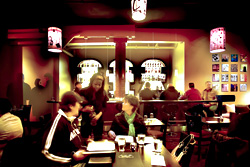There still aren’t many reasons to venture into the morass of the Denny Triangle without a map, a compass, and a St. Anthony medal. The neighborhood is the most disorienting corner of the city to drive into, where the one-way streets will channel you within viewing distance of your destination but spit you out six blocks away with no clear idea of how to get back. Though in the shadow of Seattle’s busiest shopping corridor, this is a land where only a counterculture icon like the Re-bar can flourish. South Lake Union is on the up and up, but there isn’t much in the way of existing housing or neighborhood hangouts to prevent anyone from upscaling the Triangle. Maybe the S.L.U.T. will do the trick, but a better influence might be Habesha, Seattle’s newest Ethiopian restaurant.
It’s probably the classiest place to try to upscale the hood in years, a restaurant worth dressing up for. Not because it’s snooty or overpriced—you can easily stuff yourself for $20—but because the shame of looking frumpy in a gorgeous space is too great.
The room melds traditional Ethiopian with modern Seattle. The first, and last, thing that you notice are the dozens of lamps, made by local artist Yegizaw Michael. Wrapped in creamy handmade paper and decorated with paper cutouts of Ge’ez letters and figures, the lamps make the ochers and browns of the room glow golden. There are woven bowls and rugs, but also a sleek, backlit bar, and Habesha’s exposed-brick walls contain the ghosts of arched windows past, two of which now house the restaurant’s wine supply. (FYI: the Ethiopian vintages on the menu are… well, stick to the domestic.)
I went to Habesha for dinner about six weeks after it opened, and almost dismissed the restaurant as just a pretty thing. Every mound of lentils and vegetables in the vegetable combo I ordered tasted as if it had been tossed in a pot at the last minute and barely seasoned, and the “green chicken,” breast meat cooked with bright-emerald chopped greens, had the same unmarried flavors. When I walk out of an Ethiopian restaurant feeling like I could have cooked a better meal, it’s a terrible sign. But I couldn’t shake the feeling that the room was too beautiful to ignore, and came back with a few friends.
In the intervening month, the owners had hired better cooks, or perhaps they had just been out ill on my first visit, because the food was 20 times better. To me, Habesha now seems on par with restaurants like Capitol Hill’s Queen Sheba (which is owned by the same family) or Hidmo in the ID: if not the most transcendent Ethiopian cuisine in town, still pretty damn tasty.
Ethiopian restaurant menus in America seem as fixed as Chinese takeouts, and Habesha has all the requisites: tibs, stir-fried strips of beef or lamb; the spicy chicken stew called doro wot; firfir, or torn-up injera bread blended with veggies and spices. To the standard list, owner Abiy Assefa has added a few novel tweaks, such as the green chicken (not so successful) and asa gulash, cubes of a tender, fatty white fish cooked with onions and peppers in awaze, a bright, spicy wine-garlic-berbere sauce (definitely worth a try).
On my second visit, the vegetable combination was a different platter: kike, yellow split peas, sparkled with ginger. Misser wot, or red lentils, thrummed with berbere, the master chile-spice blend that gives so much of Ethiopian food its distinctive character. Shiro wot, stewed ground peas, had the mothering texture of thick yogurt. And the mild, turmeric-tinted cabbage-carrot stew called atakilt tasted fresh, not wilted. Our habesha tibs, slices of lamb sauteed with onions and jalapeños in spiced butter, were a little chewy to my taste, but the flavors were simple and good.
The service wasn’t perfect—our waitress brought us an order of vegetarian sambusas (samosa-like pastry triangles filled with lentils) but forgot to mention that the kitchen didn’t have the meat version we also requested until we prodded her 10 minutes later. However, she noticed when more drinks were needed and offered us replacement rolls of injera just as we were tearing up our last swatches of the spongy, sour crepe.
One of my guests at that dinner had never tried Ethiopian food before, but since he liked Habesha so much, I brought him back for an advanced lesson. Doro wot, which could be called “mother and child stew” because the chicken is always served with hardboiled eggs, was an easy sell: The meat had been braised with onions and fistfuls of berbere until the sauce thickened and the meat pulled off the bone in tender chunks. I also persuaded him to try the kitfo. Though raw beef isn’t on everyone’s must-eat list, everyone I’ve introduced to the dish has fallen for it. Granted, they’ve all been prescreened:
Me: How do you feel about steak tartare?
Them: Um, OK, I guess.
Me: Mixed with melted, spiced butter?
Them: Sold.
Warmed to body temperature by the butter, the beef retains the deep purple color and smooth creaminess of raw meat. Fragrant with cardamom, Habesha’s kitfo came with the traditional accompaniments. With each square of injera, I picked up some beef, some chopped greens, and some crumbly cheese curds—a little tang to cut the richness of the meat—then dipped one edge of the bundle in mitmita, a blisteringly hot chili powder whose effects we washed away with sips of Stella. If this is gentrification, bring it on.
Price Check Lentil sambusa- $4 Habesha tibs- $13 Doro wot- $13 Asa gulash- $13 Kitfo- $12 Vegetarian combo- $13






